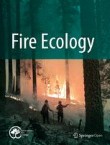Fire Ecology is the official journal of the Association for Fire Ecology.
Modelling Fire Ignition Probability from Satellite Estimates of Live Fuel Moisture Content
Biomass burning has critical ecological and social impacts. Recent changes in climate patterns and land use have involved alterations of traditional fire regimes, which have increased the negative impacts of f...
